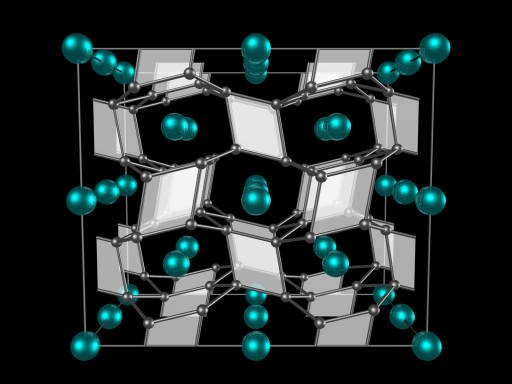First fully computer-designed superconductor
October 10, 2013
[+]
The successful synthesis of the first superconductor designed entirely on a computer has been achieved by Binghamton University assistant professor of physics Aleksey Kolmogorov and his international colleagues.
Crystal
structure of FeB4 (iron tetraboride) predicted from first principles
and confirmed experimentally. The iron atoms (small spheres) are
embedded in a rigid 3D framework formed by boron atoms (small spheres).
(Credit: Binghamton University)
The synthesized material — a novel iron tetraboride compound — has a novel crystal structure and exhibits an unexpected type of superconductivity for a material that contains iron, as predicted in the original computational study.
“Paradigm-shifting superconducting materials have so far been discovered experimentally, and oftentimes accidentally,” Kolmogorov says.
Until now, theory has been used primarily to investigate superconducting mechanisms and, in rare cases, suggest ways that existing materials might be modified to become superconductors. But many proposed superconducting materials are not stable enough to form and those that do form are poor superconductors.
Superconductors, which conduct electric current without any resistance when cooled below a certain temperature, have many interesting applications. For instance, power lines made out of superconducting materials can significantly reduce the energy lost in transmission.
The phenomenon was discovered more than 100 years ago, with breakthroughs in the 1960s bringing superconductivity into practical application. The critical temperature, or Tc, for superconductors discovered to date is between 0 and 136 Kelvin (-460 and -214 degrees Fahrenheit). Scientists are still searching for materials that are superconductors at higher temperatures and can be mass-produced.
“Evolutionary” algorithm
Several years ago, Kolmogorov, then at Oxford University, began studying boron-based materials, which have complex structures and a wide range of applications. He developed an automated computational tool to identify previously unknown stable crystal structures. His “evolutionary” algorithm emulates nature, meaning it favors more stable materials among thousands of possibilities.
The search revealed two promising compounds in a common iron-boron system, which came as a surprise. Moreover, a graduate student’s calculations indicated that one of them should be a superconductor at an unusually high temperature of 15–20 Kelvin for the “conventional” type of superconductivity.
Recently, Natalia Dubrovinskaia and Leonid Dubrovinsky, professors at the University of Bayreuth in Germany, undertook a series of experiments and produced a very small quantity of iron tetraboride in the predicted crystal structure. Detailed measurements demonstrated the material’s predicted superconducting property and, unexpectedly, its exceptional hardness.
“The discovery of this superhard superconductor demonstrates that new compounds can be brought into existence by revisiting seemingly well-studied systems,” Kolmogorov says. Now that this material has been synthesized, it may be possible to modify it and raise the temperature at which it becomes a superconductor.
“However, practical applications of the new material are not apparent at this stage,” Kolmogorov told KurzweilAI. “The key aspect of this work is the verification of the capability of state-of-the-art theoretical methods to predict brand-new superconductors, a materials class known to be notoriously difficult to develop from first principles.”
Abstracts of Physical Review Letters paper (Huiyang Gou et al.)
Single crystals of novel orthorhombic (space group Pnnm) iron tetraboride FeB4 were synthesized at pressures above 8 GPa and high temperatures. Magnetic susceptibility and heat capacity measurements demonstrate bulk superconductivity below 2.9 K. The putative isotope effect on the superconducting critical temperature and the analysis of specific heat data indicate that the superconductivity in FeB4 is likely phonon mediated, which is rare for Fe-based superconductors. The discovered iron tetraboride is highly incompressible and has the nanoindentation hardness of 62(5) GPa; thus, it opens a new class of highly desirable materials combining advanced mechanical properties and superconductivity.
Abstract of Physical Review Letters paper (A. N. Kolmogorov et al.)
New candidate ground states at 1∶4, 1∶2, and 1∶1 compositions are identified in the well-known Fe-B system via a combination of ab initio high-throughput and evolutionary searches. We show that the proposed oP12-FeB2 stabilizes by a break up of 2D boron layers into 1D chains while oP10-FeB4 stabilizes by a distortion of a 3D boron network. The uniqueness of these configurations gives rise to a set of remarkable properties: oP12-FeB2 is expected to be the first semiconducting metal diboride and oP10-FeB4 is shown to have the potential for phonon-mediated superconductivity with a Tc of 15–20 K.
(¯`*• Global Source and/or more resources at http://goo.gl/zvSV7 │ www.Future-Observatory.blogspot.com and on LinkeIn Group's "Becoming Aware of the Futures" at http://goo.gl/8qKBbK │ @SciCzar │ Point of Contact: www.linkedin.com/in/AndresAgostini
 Washington
Washington